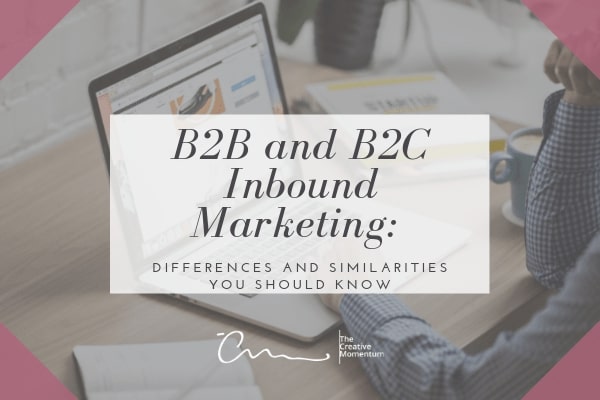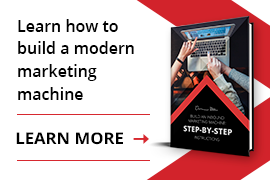
On the surface, the inbound marketing practices used in business-to-consumer (B2C) and business-to-business (B2B) have a lot in common.
Both strategies require a thorough understanding of the company’s target market. Both strategies involve addressing customers through a structured buyer’s journey framework. And overall, both strategies have the same goal: capturing prospects’ attention and giving them the nudge they need to purchase.
There are plenty of similarities, but there are also substantial differences in how they work and what customers expect. Let’s review these distinctions in more detail.
Basic Differences in B2B vs. B2C
The primary differences between B2C and B2B are how shoppers purchase and what motivates their decisions.
B2C purchasing is typically straightforward and quick. Customers find a business (usually online), browse its product catalog, and if everything checks out, they purchase. Customers might spend some time comparing options and price points, but typically, when they want something, they want it NOW.
On the other hand, B2B purchasing is a long process of discovery. Here, an employee shops on behalf of his/her enterprise, considering options, researching products, and committing to a provider capable of improving business capabilities. It’s not meant to be quick or easy. It’s a lengthy process that often takes months to complete.
Let’s dig deeper into each market’s motivations during the purchasing process.
What Drives B2C Behavior?
Given that B2C customers prefer fast transactions that let them get on with their lives, B2C marketing is all about simplicity, convenience, and building a quality user experience.
Think about how users typically shop. More often than not, ease of access is a primary motivator for purchasing, particularly in the instant gratification Amazon era. Consumers want to find the products they want and make a quick purchase without needing to go through an extensive shopping process.
But simplicity isn’t the only motivator. Typical buyers tend to be emotion-driven in their shopping, often purchasing products on a whim and preferring brands that can make a clear case for a how a product will improve their lives. Related to that, consumers tend to rely on social proof. We’re all familiar with how people will post shopping ideas on social media, getting their friends’ opinions and validation before going through with the buy. Making it easy for them to share is an important part of B2C inbound marketing success, as we’ll detail below.
To summarize, these are the key drivers of B2C purchasing intent:
- Convenience in shopping
- Positive emotional associations
- Social validation
What Drives B2B Behavior?
B2B buyers take a structured, logical approach to their purchasing.
There’s no room for emotion here; B2B buyers are less interested in emotional appeals and convenience than the belief that they’re making the right decision for their enterprise. As such, the B2B purchasing process relies on information delivery, transparency, and trust.
This desire for in-depth information makes sense when you consider how much more effort the typical B2B buyer puts into a purchasing decision. B2B purchases tend to be far bigger than those in B2C, often ranging in the thousands of dollars. There’s a lot more at stake in every purchase. And on top of that, B2B purchasing typically involves multiple stakeholders.
For example, a business wanting to purchase a new software platform may need the input of the IT department, the CTO, and financial teams before a decision can be made. This is another reason that content delivery is so important; when buyers narrow down their options, they need supporting documentation to help make the decision.
Overall, B2B buyers need to be able to find the information they need right when they need it, and they need to be able to trust that the vendor will deliver on its promise. After all, many B2B purchases aren’t just one-off sales; they’re investments in vendors who will, ideally, become long-term service partners for the enterprise. And if the B2B buyer can’t trust the vendor, this type of arrangement is impossible.
To summarize, these are the key drivers of B2B purchasing intent:
- Effective information delivery
- Assurances that vendors can deliver
- Potential for long-term partnerships of mutual value
How Do You Reach B2C Buyers?
Reaching B2C buyers involves creating a great web experience that gives them the information they need. In one study, 76% of consumers agreed that being able to find what they wanted on a website was the most important aspect of the site’s design.
Remember, the average customer wants things fast and easy. They want to feel good about their purchases, and they’re not afraid to seek social validation before committing. As such, you should structure your web layout to accommodate these trends:
- Create a simple, clear web layout that makes it easy for users to browse products.
- Make the ordering/checkout process as simple as possible and be sure to include all pertinent purchasing details in the shopping cart.
- Include high-resolution images (and social sharing buttons) throughout the page that make it easy for them to involve their friends.
How Do You Reach B2B Buyers?
For B2B buyers, the best way to engage is to work on your site’s content assets, marketing campaigns, and web layout to prioritize information delivery. This is a bit more complicated, as a tightly-integrated B2B buying funnel involves addressing buyers at every stage of the purchasing cycle and being aware of the best moment to make contact. (Though much of the research is done online, 80% of business buyers expect some type of real-time interaction with prospective brands. Keep these elements in mind:
- Work on content marketing assets that provide insight and information into each product and make materials easy to share.
- Learn more about customer touchpoints and when buyers will be most amenable to direct marketing messages delivered via email and other channels.
- Make long-term support a priority and stress that the purchasing arrangement will be more of a partnership than a single transaction.
Mastering Your Inbound Marketing
We could spend all day writing about the marketing differences between B2B and B2C, but this primer should give you a good start. But even though there are some big differences between the two, remember that your fundamental goal is the same: delivering the type of shopping experience that suits their goals and makes the buying process as simple as possible.

